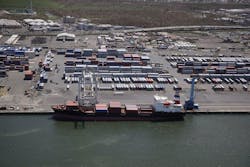US Trade Gap Widens to 10-Year High Amid China Tensions
The U.S. trade deficit widened more than forecast in October to the highest in a decade, underscoring continued fallout from the trade dispute with China. The goods trade gap with China widened to a record.
The gap increased by 1.7% to $55.5 billion, from a revised $54.6 billion in the prior month, Commerce Department data showed on Dec. 6. The median estimate of economists surveyed by Bloomberg called for a deficit of $55 billion. Imports of all goods and services rose to a record, while exports were little changed.
President Donald Trump has made reducing the U.S. export-import imbalance with China one of the primary goals of his trade wars. The evidence, as reflected in the latest figures, shows his assault isn’t working yet.
Net exports may again weigh on growth in the fourth quarter -- albeit less than in the prior three months -- amid a strong dollar and continued uncertainty over trade policy. Data are likely to remain volatile, reflecting a rush of activity ahead of U.S. threats to further raise levies, and a subsequent unwinding of that effect should Beijing restart some imports.
Overall exports came in at $211 billion after $211.4 billion the prior month. That included record shipments of petroleum, industrial materials and consumer goods.
Imports rose 0.2%to $266.5 billion from $265.9 billion, reflecting record purchases of autos and consumer goods. The overall merchandise-trade deficit was also the highest ever.
The report showed the unadjusted goods-trade gap with China, the world’s second-biggest economy, widened to $43.1 billion in October from $40.2 billion.After eliminating the influence of prices, which renders the numbers used to calculate gross domestic product, the goods trade deficit rose to $87.9 billion from $87.2 billion in the prior month.
American soybean exports continued to slide, reflecting a reversal of the run-up earlier this year ahead of China’s retaliatory tariffs on the U.S. The data showed that soybean sales to overseas customers plunged by almost half in October from the prior month.
Beyond agricultural products, the tariff headwinds are hurting businesses more broadly, with rising prices for materials and supply-chain disruptions. Cooling global growth also would be a hurdle for exports of American-made goods.
The wider trade gap comes at the start of a quarter in which the economy already is projected to moderate, after posting the best back-to-back growth since 2014. The negative fallout may be smaller compared to the third quarter when the drag from net exports matched the worst since 1984.
By Shobhana Chandra
